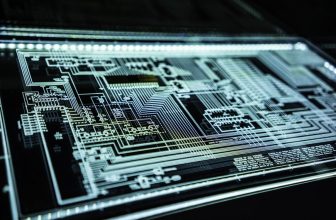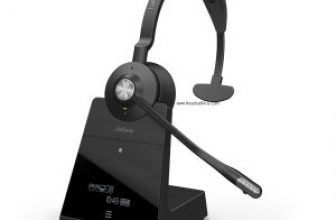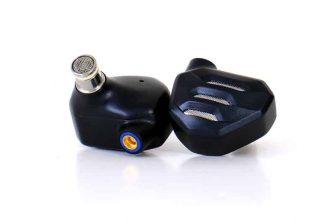
In this feature, we review the EarMen CH-Amp which is a high-end composite topology headphone amplifier paired with a dedicated linear PSU. It is priced at $1480.
Disclaimer: This sample was sent to us in exchange for our honest opinion. Headfonics is an independent website with no affiliate links or status. We thank EarMen for their support.
You can click here to learn more about EarMen products previously featured on Headfonics.
Note that this article follows our latest scoring guidelines, which you can read in more detail here.
EarMen, in its inception, originally chose to specialize in the portable audio gear niche most notably with their dongle line up such as the Colibri and the Sparrow, as well as portable amps like the TR-Amp.
So fast forward a few years their lineup has now grown to include a few more excellent portable amps such as the Angel and the gradual development of a full desktop-class stack setup.
Their first entry was the Tradutto DAC which in our review was still missing an amplifier. Now after almost a year, we’re finally able to check out the matching CH-Amp, a 3.8W balanced capable amplifier combined with a hefty PSU-3 linear power supply.
Tech Highlights
Inside the CH-Amp is a composite amplifier topology that ideally brings in the advantageous characteristics of an AC and DC design. This technology isn’t novel to EarMen, but when applied in an audio amplifier, it removes any thermal feedback loop error and improves the circuit performance.
Power-wise, the CH-Amp is not exactly a head turner in today’s competition with its 3.8W maximum power output. Looking at it practically, I still think EarMen packed the CH-Amp with more than ample amounts of power for any modern headphones.
Users can appreciate the fully balanced design of the CH-Amp with the 4.4mm jacks found in both ends of the unit. Know that even with a single-ended input selected, the balanced output will work with the amplifier working to convert the signal without any phase shift.
Lastly, the CH-Amp won’t be complete without its external low-noise linear power supply. The PSU-3 offers all the merits of a linear power supply but EarMen didn’t go to lengths about what’s inside aside from it being protected against current overload, thermal overload, and short circuits.
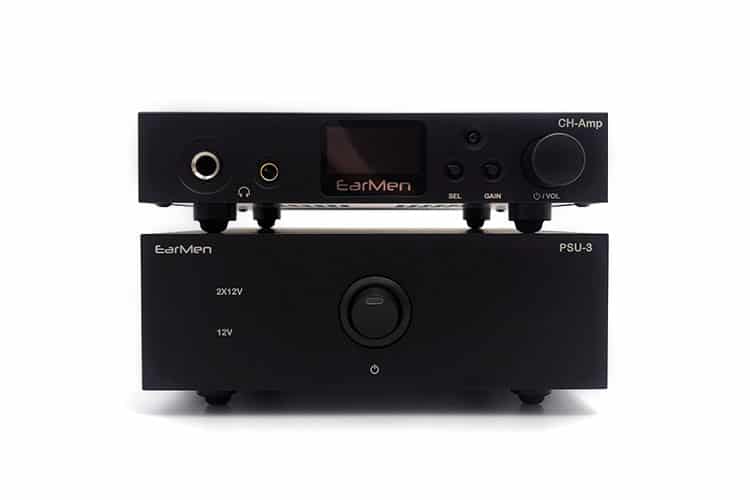
Design
It may not seem like it in pictures online but the CH-Amp is a pretty compact setup in person. The stack will start to get tall once you add the Tradutto and Staccato on top, nonetheless, its footprint will stay more or less palm-size comparable.
Try lifting the unit however and its roughly 2.14kg total weight straightaway reveals that it packs some serious business.
Scrutinizing the full block aluminum chassis of the CH-Amp felt tight and solid with the only slight remark that its cornered edges could feel pointed. Still, this straightforward design by EarMen will make a case for audiophiles that enjoy a clean and cool listening station.
Cosmetically, the main draw of the CH-Amp will come from the OLED display at the front of the device with a proud EarMen marker below. To its right is a triangularly arranged button array and an IR receiver mounted flush to the face.
The volume knob is digital so it doubles as a power switch and mute button. It is a bit small and may move the amplifier when pushed inwards but I find it easy to turn when controlling loudness.
Both the CH-Amp and the PSU-3 are held by fairly tall chunks of rubber feet that raise the combined height of the stack. This may be a functional decision since below the amplifier are vent holes punched in a screwed-on plate used for passive cooling.
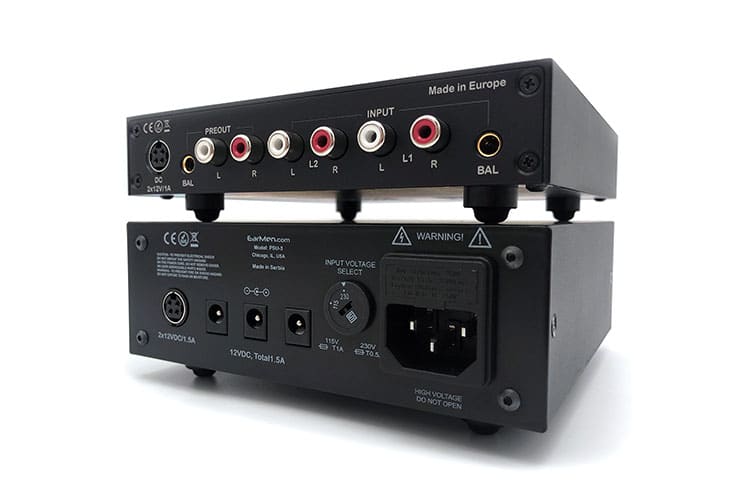
I/O
The PSU-3 is designed with a 230V to 115V switch to make it a globally available unit. And standing as the in-house built power supply for the CH-Amp it includes a 2x12V DC outlet aside from the three 12V DC contact points that logically paints its versatility to when the stack is completed with the Tradutto and Staccato.
Looking over to the star of the show, the CH-Amp, even with its diminutive package is not limited to single-ended connections through its utilization of the practically compact 4.4mm balanced jack in both its inputs and outputs.
From the front, awaiting is a mighty up to 3.8W of output power for both the 6.35mm and 4.4mm outputs. However, run the CH-Amp in a single-ended configuration and the headphone jacks will be limited to a maximum of 1.5W.
When I inspected the rear ports of the CH-Amp what got me excited is its accessibility. Not only does it offer a balanced option but its inputs at least on the single-ended side are doubled by having two pairs of RCA sockets on hand.
It may be only me but I find the assignment of the left and right RCA ports a curious matter. I was connecting it to my DAC when I noticed that the left channel is placed on the right, reversed to how my other equipment usually is.
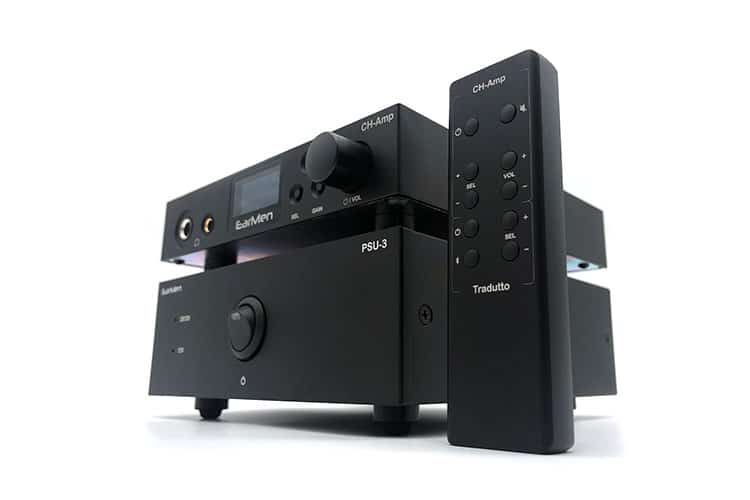
Controls
Since I don’t have any other way to power the CH-Amp aside from the 2x12V DC output from the PSU-3, using them together throughout the review is the most logical way to go. I believe most will do the same thing since aside from being part of the package, it has some technical merits to add as well.
Flipping the snappish toggle to turn on the power supply lit up a blue LED followed by an audible snap from two relay clicking into place. Once the power reaches the CH-Amp it will go into standby mode meaning the remote could already be used to turn it on or press the volume knob if the remote’s battery is dead which was the case for me at first.
Others though may find EarMen’s way of resetting all the settings every time the amplifier starts annoying. But what I like about this method is it prevents accidental hearing damage due to the volume being set too high from a previous session.
Each time I restart the CH-Amp it defaults to the balanced input with the volume set to zero and the rear pre-amp actuated. Plug headphones in and it will switch the output as confirmed by the display that sound is now coming through the front, still with the volume at zero and always at low gain.
Changing the input is simply done by pressing the select button up at the front of the device or with the supplied remote. The gain can also be changed this way, only this time, CH-Amp’s control is the sole access point since there is no dedicated gain switch on the remote.
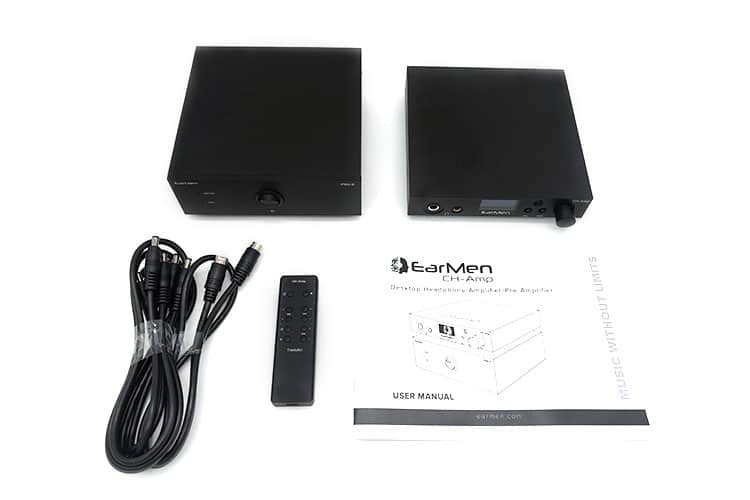
Packaging & Accessories
What I can say is that EarMen do know how to make a good first impression. The CH-Amp did arrive in a plain Jane protective white box with minimal labeling and no padding whatsoever. However, check inside and a proper premium-looking package awaits.
The outer sleeving shows the stacked amplifier and power supply together in a backdrop of a dancing speckled pattern. Remove this and a thick and magnetically shut black box with an EarMen logo on top and each side will flicker in multiple different colors depending on where the light hits it.
Now, get ready for a ton of squishy foam fillers since EarMen layered the inside of the box of the CH-Amp with a lot of them for protection.
The first thing to see inside is the booklet-style user manual followed by two layers of foam to protect the amplifier on the left and the rechargeable remote on the right. Underneath are two more layers of padding to cradle the bulky power supply and cables.
What I immediately noticed though is the lack of a power cable for the PSU-3. Out of the only four cables provided, three are for the 12V DC outputs and one is for the 2x12V DC output reserved for the CH-Amp socket.
Sound Impressions
Summary
I wouldn’t consider it yet as EarMen’s house sound since my experience with the brand is quite thin, but between the CH-Amp and the Angel, it is easy to pick out the similarities. But let me tell you early on that the Angel is not a CH-Amp stand-in since the latter more than fixes what the pocket-sized DAC/Amp lacks.
A key ingredient to making the CH-Amp an absolute winner is the sense of scale it adds to the sound set in a startlingly black background. EarMen isn’t pulling punches in this department for a vivid and transparent composition that has the chops to let a good system shine without reserve.
The bass region of the CH-Amp is infused with a controlled level of excitement that thoughtfully does not outbalance the pace. It will easily fly under the radar until a well-isolated thump shows the CH-Amp’s talent in dynamics and punch.
Where I’d like to put stress is in the rest of the frequency where the revealing nature of the CH-Amp offers in most cases what seems to be a caring attitude with a touch of oomph. Having an honest sound in this case will take you far but don’t expect the CH-Amp to be shy when a vibrant singer or instrument plays.
Timbre
No matter what genre, the CH-Amp gobbled up everything I threw at it and presented a mature sound that quite honestly exceeded my expectations coming into this review. A combination of skill in working out the subtleties of a song and its composure in tonality makes for a really strong pitch.
Reflective of the gear being paired, expect a fast clean punch that has an insightful nature since instruments are isolated and set in place. The scattering edges help create a sense of scale to the beat without smearing its neighbors.
The CH-Amp once again exhibited its potency in picking up subtleties with the incisive performance it delivered to stringed reverb as each transient is delicately shown. Clean and with no signs of coloration, its only objective is to accurately express the definition and size.
Making the most use of the dark background of the CH-Amp is the vocal region. The quality and separation of the image put the singers in a distant position that vividly highlights every breath and quirks that may be missed in a less capable system.
I will say though that with a bright female singer, the timbre could be anemic and stiff. Though normally, it stays true to the expected amount of fullness deepened with a refined smoothness that bites when necessary.
Steely chimes easily penetrate a scene with bold and bright energy just like how a brass instrument will not hide its presence though the CH-Amp skillfully assembles it into a definite space. Horns, in particular, sounded a bit raw and dry which when heard with a violin becomes an asset for a pristine and engaging presence.
Staging & Dynamics
The CH-Amp isn’t gunning to be the widest staging amplifier around. EarMen chose the more natural approach by preferring to showcase a realistic soundscape that is generally wide enough to peel through the layers of a song one by one.
I believe it is the combination of the timbre and dynamics of the CH-Amp that in a busy situation like a rowdy audience clapping and screaming in a stadium, it felt strangely believable for a moment. It also spaced out each image easily and used up the entire soundstage to allocate placement.
Even with far objects like a guitar playing quietly in the background, there will be no blurring when homing in on that particular area. Noticeable as well is the bigger size the CH-Amp gives to instruments putting it into the spotlight in reverse to the more moderate center image where the vocals usually are.
Click on page 2 below for pairings and our select comparisons.
creditSource link




